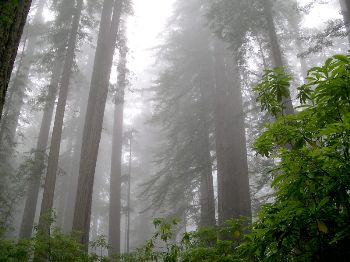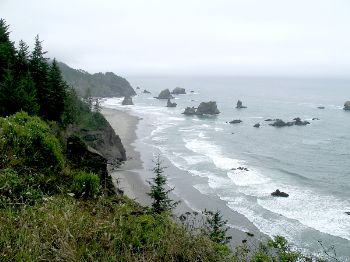by Larry
August, 2007The Redwood National and State Parks of California
The state and later national parks set aside for the preservation of coast redwood forests include 37 miles of gorgeous Pacific seashore, multiple rivers and smaller streams, coastal hills, dunes, elk meadows, and thousands of acres of probably the tallest living things (up to 385 feet in height) the world has known. The oldest of the coast redwood trees are around 2000 years young. The base of a fully grown redwood is up to 22 feet in diameter. The bark gets up to 12 inches thick, offering protection from most fires. Yet, if they do get badly burned, redwoods tend to put out new growth, which can become whole trees, if only a fraction of their trunks remains alive. For all their immense size at maturity (weighing up to 500 tons), coast redwood cones are but an inch long. The trees germinate from seeds no bigger than those in tomatoes. Their woodlands dominate many of the northern sides of hills adjacent to the CA coast, taking full advantage there of moisture from both abundant fog and rainfall. They also do well near or on slopes next to large streams close to sea level. From whatever source, each mature redwood requires several thousand gallons of moisture weekly.
Not only the rich, soft redwood forest floor but also a multitude of tree canopies contain hundreds of other species. Even salamanders are found in the high canopy habitats. It is a mystery how they get there. Life within the redwood parks is as diverse as the geography. In or on the Pacific deeps, besides the underwater fauna and flora, there may be seen gray and killer whales, porpoises, seals, dolphins, sea lions, brown pelicans, and cormorants. The intertidal zone is luxuriant with periwinkle snails, beach hoppers, sea gulls and other shore birds, seaweeds, kelp, mussels clinging to scenic rocks, barnacles, sea urchins, starfish, limpets, erect sea palms, and giant green anemones. Slightly more inland, the Pacific beaches are home to crabs, clams, sanderlings, and desert like dune creatures and vegetation. Bluffs or cliffs frequently mark the divide between the seashore and the inland slopes. Many birds, such as puffins and pigeon guillemots or cormorants, nest here. Steelhead, cutthroat trout, and Chinook salmon can be found in redwood park streams. Many colorful and intriguing invertebrates, such as long yellow banana slugs or yellow-spotted millipedes are common in these areas. Elk, black bears, and many other mammals inhabit redwood park meadows or woodlands, filling some of the niches today that would have been represented by dinosaurs during the Jurassic age. Stands of coastal redwoods have been compared with cathedrals and other religious sites, but to me they are more majestic than man-made structures. And, in a period of rapid change, they remain awesome living links between us, the far distant past, and an uncertain future. When redwoods' unique habitats have disappeared, ours will surely be more impoverished as well. |
 Present day redwoods comprise only 4% of their greatest numbers and acreage. Tough specimens though they are, coast redwoods have been succumbing to a combination of logging, urban or agricultural development, and climate change, forces which currently persist. While the redwoods remain, let us celebrate these friendly giants and their special environments.
Present day redwoods comprise only 4% of their greatest numbers and acreage. Tough specimens though they are, coast redwoods have been succumbing to a combination of logging, urban or agricultural development, and climate change, forces which currently persist. While the redwoods remain, let us celebrate these friendly giants and their special environments.
